https://medium.com/@mparker.isa/the-protection-of-public-officials-a-democratic-imperative-6ae42fff8917
The Protection of Public Officials: A Democratic Imperative
“Do you feel safe? You shouldn’t,”
“Your security detail is far too thin and incompetent to protect you. This world is unpredictable these days….anything can happen to anyone.”
Travis Ford of Nebraska in his threats to a local election official.

Bottomline:
Elected and other public officials are afraid of violence, so fearful that many have confessed to not voting for a piece of legislation over these fears.
Many of these elected officials are part of the problem, using violent rhetoric to demonize a political opponent.
Many of these elected officials are part of the problem because they refuse to accept the security measures necessary to allow them to live and work without fear.
Overview: Seriously, are we writing about this again?
Since 2017, the Independent Security Advisors Defending Democracy program has published over seventeen articles addressing threats to public officials and emphasizing the need to protect these officials to safeguard our democratic process as a whole.
And since our first article, to the surprise of some, we have called out Members of Congress for ignoring these threats.
Wait, what?
Yes, we have called out members of Congress and others because their common refrain is, “I don’t want security,” and so on. Well, congressman, tough. You are an elected official, a representative of your district and constituents. The democratic process doesn’t function if you’re dead or scared to attend meetings or to vote your conscience. So, if there is a threat, you have an obligation to accept the measures needed to protect your vote.
We have also criticized law enforcement leadership in districts with “colorful” and “outspoken” elected officials for being unprepared or unwilling to offer sufficient protection for their officials.
Chiefs commonly cite “mission creep,” which may overextend their manpower or budget, so they want to avoid providing officers for protective assignments. However, the Capitol Police and congressional Sergeants of Arms often look to local law enforcement for assistance.
Therefore, we have attempted to assist by recommending numerous programs and ideas that provide local law enforcement with the necessary assets, resources, and training needed to support these requests.
Thankfully, we are not the only ones discussing this issue. We have shared articles and news reports from journalists, subject matter experts, and researchers who write more eloquently on this topic than we do.
**Welcome to Other Voices: Introductions**
As we update this article on the protection of public officials, we would like to introduce you to some of our sources and other respected voices on this issue.
Organizations such;
The Combating Terrorism Center at West Point
The Department of Homeland Security
The Bridging Divides Initiative (BDI)
The Brennan Center for Justice and
The Joint Counterterrorism Assessment Team (JCAT) — a collaboration involving the National Counterterrorism Center (NCTC), DHS, FBI, and the Justice Department’s Election Threats Task Force
Each of these organizations has published numerous reports, studies, polls, and warnings about the threats to public officials and the dangers facing our democratic system.
We are taking this opportunity to mention these other valuable sources because, for the first time since we wrote this article on September 24, 2024, another author in another article has mentioned one of them.
Don’t do us any favors
In an article published by Stateline titled “Minnesota Assassination Prompts Many Lawmakers to Wonder: Is Service Worth the Danger?” written by Alex Brown and Robbie Sequeira, the authors mention the Brennan Center for Justice.
However, for some unknown reason, the authors felt it necessary to label the Center as “progressive-leaning.”
Attn: Stateline, (part of States Newsroom)

Note* Question: Why attempt to discredit a source you’re using for your article by calling them progressive leaning?
You just told the 30% that leans right to ignore everything this organization has to say. Why not go for the trifecta and call them the WOKE, DEI supporting, progressive-leaning BCJ?
Of course, we could reach out to the Editor, Scott S. Greenberger, at: info @stateline.org to ask, but we are just so overwhelmingly happy they wrote an article on the topic. Why jinx it.
The Beginning: What made us write this article?
“Here we are in the aftermath of the July 13th shooting of a former president, still calling out from the dark, asking for funding, legislation, and some semblance of recognition of the threats to our state and local officials”.
Matthew Parker, original co-writer.
When we sat down to compile this data-filled discussion on the protection of public officials, an attempted assassination of a presidential candidate had occurred in July. Unbeknownst to us, just a few weeks later, Ryan Routh would be arrested near Donald Trump’s golf course in Florida and charged with attempted second assassination.
Then, on Sunday, April 13, 2025, Governor Josh Shapiro and his family were awakened to a fire at the Pennsylvania Governor’s Residence, which was caused by arson.
So that brings us sadly to today and the assassination of Minnesota State Rep. Melissa Hortman, her husband, Mark, and the shooting of State Sen. John Hoffman and his wife, Yvette.
Irony
Note* The Minnesota shootings took place just a day after we published our 18th article, Defending Democracy: The Urgent Need to Protect Public Officials, https://www.eptraining.us/defending-democracy-the-urgent-need-to-protect-public-officials/blog/
But We Are Not Alone: Other Voices
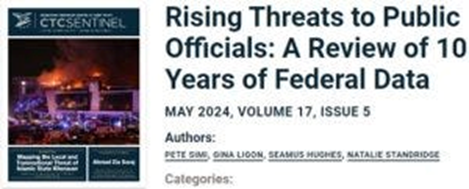
In 2024, the Combating Terrorism Center at West Point published the study “Rising Threats to Public Officials: A Review of 10 Years of Federal Data.” The authors point out that the Department of Justice found an increase in “threats targeting education officials such as school board members, administrators, and faculty”.
This is good news because it confirms one of our major points about the growing number of local officials and their agencies at risk. This provides another source of information on threats to public officials. This was in 2024, nine years after our first article calling for increased protection of local and state public officials.
Misguided Voices
Unfortunately, the CTC report mentioned above also notes, “There is a tendency among some observers to focus on threats as a ‘nuisance’ primarily initiated by individuals ‘blowing off steam,’ who will likely never act on their threats.”

“But who are these ‘observers’ that, in today’s political climate, think these threats are just ‘individuals ‘blowing off steam?”
We no longer have the luxury of just sitting back and “observing” because if recent history has taught us anything, it’s that some of these threats are not just blowing off steam.”
Matthew Parker, CEO, ISA
Returning to the article published by Stateline, written by Alex Brown and Robbie Sequeira,
Michigan state Rep. Laurie Pohutsky, who states in the article that “she has faced multiple death threats since 2020,” is also quoted as saying, “People treat death threats against government officials as a matter of course until someone is assassinated.”
So, we have a report that notes apathy towards threats and an elected state representative who says ‘it’s just a matter of course”. Could it get any worse?
Well, heck yes. Let’s introduce you to South Dakota GOP Sen. Mike Rounds and look at some other public officials living in an alternate reality.
From: NPR article “Lawmakers in Washington press for more security following Minnesota shooting ‘
June 16, By Deirdre Walsh & Claudia Grisales
In this outstanding article, the writers note the following: “Some lawmakers expressed skepticism about the calls for increased security”.

Point of order, Mr. Chairman, at what point does “skepticism about increased security’, get replaced with the realization that public officials have been shot, assassinated, their family members shot, their pets shot, their husbands attacked with hammers, and their homes invaded?
A follow-up, Mr. Chairman, “How many constituent meetings and other public events do officials cancel or avoid for fear of their safety?
Back to the NPR article, the writers highlight South Dakota GOP Sen. Mike Rounds who noted that “those who were shot on Saturday were state legislators”, and he goes on to say that “he served in the statehouse for 10 years”, and “it wasn’t feasible to have security at all times”.
The South Dakota member of Congress goes on to say, “My question would be how far do you go and at what point?”. Given that he points out “the U.S. Capitol Police authorize additional security for House members and Senators “when there is a known threat.”
Response:
Well, Senator, Gabby Giffords and Steve Scalise were members of Congress, not state senators. And both were shot. And yes, those killed and wounded in Minnesota were indeed state representatives.
And you go as far as you need to to mitigate the threat. The Capitol Police are not in your district, so you will need to rely on local law enforcement or private sector security.
As such, I wholeheartedly disagree that having security at all times is not feasible. It certainly is. The Capitol Police threat assessment team, working in conjunction with your local and state police, can provide your staff’s LE-security representative with the current threat level, source, and recommendations to mitigate the threat.
Mitigation does not always mean bodyguards and motorcades.
A Lesson on Threat Assessments and Mitigation.
Is your threat level high, moderate, or low?
Is the source of the threat internal, external, or self-generated?
And is it a violent physical threat or non-violent?
If your threat is low and non-physical, such as from non-violent protesters at an open meeting, reduce the danger by having your staff meet with the protesters before you arrive. Seat them in designated areas or behind barriers. These are security measures.
You don’t always need a “bodyguard,” but you do need security awareness and someone assigned to coordinate with the Capitol and local police.
However, I am also confused about your position on this topic because the article states that when House Democrats requested more or better security, it’s reported you said, “That’s not a bad idea.” and “It’s not just the members who are at risk; it’s also their staff who are at risk.”
If you understand that truth, then you should support closer coordination with Capitol and local police, along with a willingness to adjust security measures based on the level of threat. Measures that may include close protection.
Leadership Speaks
House Minority Leader Hakeem Jeffries, D-N.Y., and Rep. Joe Morelle, D-N.Y., are reported to have sent a letter to House Speaker Mike Johnson, urging him to take further action to protect members.
“Member safety must be an area of common ground. Representatives from both sides of the aisle have endured assassination attempts that changed their lives and careers forever,” House Minority Leader Hakeem Jeffries, D-N.Y., and Rep. Joe Morelle, D-N.Y.

Question: How does this differ from the 31 members of Congress who wrote that they wanted better security on January 7th?
Question: If we listened to the reports, studies, and evidence that threats are growing, could we get serious and actually protect our elected and public officials?
Now, before addressing that, let’s also quickly look at this quote:
“Too many other patriotic public servants have left Congress because they no longer felt safe carrying out their duty as elected officials.
We must act to protect each other and preserve this great American institution.”
House Minority Leader Hakeem Jeffries, D-N.Y., and Rep. Joe Morelle, D-N.Y.
Left Congress? How about the school board, election volunteers, and local health departments? How about mayors, city councils, or state representatives who are quitting? We wrote about this in 2017 and 2018.
We have also discussed the impact on our democratic process when elected officials are afraid to vote their conscience or in the best interest of their constituents. Rep. Liz Cheney is known for saying members of Congress sometimes change or refuse to vote out of fear for their safety.
Donald Nieman, a history professor at Binghamton University in New York, reinforces Rep Cheney’s contention in an email to Stateline where he says;
“That fear for personal and family safety is increasingly common among elected officials, affecting even how they vote.”
You can read more on this at https://www.eptraining.us/defending-democracy-the-urgent-need-to-protect-public-officials/blog/ section Threats Shape the Work of Democracy and in Defending Democracy and the Political Process, https://www.eptraining.us/defending-democracy-and-the-political-process/blog/
Ok Moving on
Politico Article: ‘People are scared:’ Members of Congress ask what they’ll do to keep themselves safe; By; Katherine Tully-McManus and Nicholas Wu; 06/18/2025
In this article, which I can say is a must-read for anyone working with public officials, the writers point out, “On the Capitol grounds, they’re surrounded by layers of security and a police force that was dramatically overhauled after the riots of Jan. 6, 2021.”
Well, of course, members are now more secure. The findings and recommendations of the Task Force 1–6 Capitol Security Review, overseen by my former Brigade Commander, Lieutenant General Russel L. Honoré, were implemented.
Matthew Parker, Co-Author
Hold the Phone
These reporters also point out “back home in their districts, members of the House and Senate are feeling increasingly exposed” following the shootings in Minnesota.
Well, you may wonder why members of Congress still feel vulnerable. However, you didn’t listen to the rest of the report, which addresses protection in their districts. And surprise, surprise, it’s Groundhog Day on Capitol Hill because we discussed this and solutions four and a half years ago.
https://www.eptraining.us/defending-democracy-protection-of-elected-officials-part-6-why-didnt-you-just-listen/blog/
Well, maybe they did, Sort of…
The Politico Article mentions that the Sergeants at Arms and Capitol Police have a program that coordinates local and Capitol Police resources to secure members’ in-district events.
But this program depends on mutual aid agreements, and while it’s reported ‘more than 100 state and local police departments across the country.’ are already on board, the underlining point is it all depends on “hoping that local law enforcement can help fill the gaps in protection faced by members of Congress when they’re back home.”
Former Capitol Police Chief Thomas Manger says these resources are still “just a fraction of what would be needed for every member to have access to seamless security coverage in their home state or district.”
So, please let me get this straight: Capitol security is better, district security is still inadequate, there is not enough funding, Congressmen want to spend funds as they wish rather than as the security experts believe is best, and by the way, several members don’t want security because they are private individuals.
Ok, Moving on to Part II
Politico Article: ‘People are scared:’ Members of Congress ask what they’ll do to keep themselves safe; By; Katherine Tully-McManus and Nicholas Wu; 06/18/2025
Republican Rep. Tim Burchett of Tennessee has requested a larger budget so House members can allocate funds for security expenses, including “around-the-clock” security personnel with fewer restrictions.
Well, finally, that is a well-thought-out and responsible request.
However,
ok, stop. Why is there a however? Why is it that there is always some member of Congress who thinks they know better, and they throw out a ‘however”?
Ok, continue. It is reported that “lawmakers are divided over’ new safety or security measures that may ‘restrict their freedom of movement, limit their interactions with people, and intrude on their family life.”
Que Sen. Markwayne Mullin & Sen. Richard Blumenthal
“I don’t want to have security on me. I’m a very private person. I like to go outside and be by myself,” added Sen. Markwayne Mullin (R-Okla.)
Sen. Richard Blumenthal (D-Conn.) believes security measures must be implemented in a “unobtrusive and non-interfering” way with lawmakers’ work.
“I have no intention of changing the way I live or do my job, because accessibility is part of who I am as a public official,” “But I understand how people are scared.” Sen. Richard Blumenthal (D-Conn.)
With all due respect, gentlemen, it appears you have never had a proper threat assessment or a well-trained detail because your objections are non-issues.
First, let’s say this again for the 19th time.
“Your protective detail, when properly trained and led, does not, will not, restrict your freedom of movement, or limit your interactions with people, or intrude on your family life.”
A protective detail can facilitate your freedom of movement, allowing you to meet and speak with people, and a good team can be almost invisible to the family.
Que Sen. Markwayne Mullin & Sen. Richard Blumenthal
“I don’t want to have security on me. I’m a very private person. I like to go outside and be by myself,” added Sen. Markwayne Mullin (R-Okla.)
So go outside, congressman, be by yourself. What is stopping you? Your threat assessment doesn’t mention an assassination, so feel free to go outside. If the assessment changes, a detail will secure the space and allow you your private time.
Sen. Richard Blumenthal (D-Conn.) believes security measures must be implemented in a “unobtrusive and non-interfering” way with lawmakers’ work.
I refer my colleagues to the comments I made a moment ago.
And we address these non-issues in Defending Democracy: A Congressional Security Wake Up Call https://www.eptraining.us/defending-democracy-congressional-security-a-wake-up-call/blog/
The Threat: It’s inside us
Troubling Signs
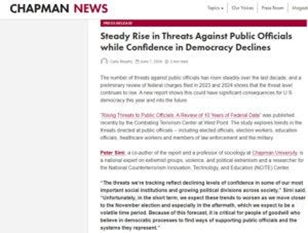
The following quote is from Chapman University’s Peter Simi, co-author of the CTC report and a sociology professor at Chapman University. One of the co-authors of the Combating Terrorism Center at West Point study.
“Declining levels of confidence”
“The threats we’re tracking reflect declining levels of confidence in some of our most important social institutions and growing political divisions across society,”
For this section of the article, we break down this quote into two parts. One examines the loss of confidence in our social institutions, and the other focuses on the growing political divisions.
Please Understand;
As we lose trust in the institutions we once respected, some individuals will turn to other groups and organizations that share the same groupthink, bias, anger, and dissent.
This shared anger feeds itself and grows beyond simple frustration or bias. It can become directed anger toward a perceived “enemy of the state.” This kind of anger is emotionally driven and can lead to a frenzy where individuals or groups become emotionally overwhelmed and lose their objectivity.
They may start using phrases like he/she is destroying our country,” “they hate America,” and “we must stop our enemies,” forgetting that these “enemies” are often just fellow Americans with different views on a policy or philosophy.
Ideological motivation
In the 2024 The Combating Terrorism Center study, they spent a considerable amount of time and effort determining “the proportion of threats to public officials that involve an ideological motivation.” In short, the emotional justifications for the threats against officials.
We strongly recommend that anyone in the executive protection, private sector, or law enforcement read this study if they are responsible for protecting a public official.
Matthew Parker
Emotional Decision Making = Ideological Grievances
Since 2011, ISA instructors have used the phrase emotional decision-making to explain how a normally intelligent person could consider and then carry out threats against public officials.
We have referred to the topic or motivation behind the emotion as a trigger, for example, the 2nd amendment and the perception of losing one’s right to own a gun, or the right to, or banning abortion.
The most emotionally affected individuals may resort to violence, overriding their usual self-control, which would typically prevent them from acting out of character.
Numbers speak volumes
The CTC in their study examined federal cases where a defendant “expressed ideological grievances,” which we interpret as those triggers. They reported that 45% of those accused of making or carrying out a threat displayed “ideological motivation.”
What concerns us in the executive protection and law enforcement community is that they found the number of emotionally driven or “ideologically motivated” cases increased from 24% in 2013 to a peak of 58% in 2021 after the election cycle.
From 2013 to 2022, “ideologically motivated threats” against public officials steadily grew.
Triggers
How these threats break down by ‘trigger points” is predictable; 43% were anti-government, anti-authority violent extremists. One example given in the study was of a Maryland resident in 2016 threatening to kill President Obama and multiple members of Congress because of “government corruption is out of control” and “treason against America” by officials who “sold out America.”
As we have mentioned previously in other articles, when you combine trigger points such as politics and race, you’re also going to see an even more violent and dedicated group prepared to use violence.
In the study within the anti-government group, 23% also had racist or extremist views.
The study also mentions the April 2019 case of a pro-second amendment Florida resident afraid of guns being confiscated. So, this individual targeted Representatives Eric Swalwell, Cory Booker, and Rashida Tlaib, with openly anti-Black and Islamophobic racism and anti-government sentiments.
What makes these cases so dangerous is that none of them are from Florida. This threat looked outside their immediate community for a target for their anger.
The study further noted that 19% of the “ideologically motivated threats” to public officials were solely classified as race-based, and those with single issue-specific triggers, such as animal rights and the environment, at 6% and 9% respectively.
The study noted that 19% of the “ideologically motivated threats” to public officials were solely classified as race-based.
When triggers collide
Paul Pelosi
There is no better demonstration of Emotional Decision-making = Ideological Grievances than the October 28, 2022, attack on Paul Pelosi, the husband of the 52nd Speaker of the House of Representatives, Nancy Pelosi, by a far-right conspiracy theorist, David DePape, who beat Mr. Pelosi with a hammer during a home invasion.
Mr. DePape had a history of mental health issues and drug abuse, which may have affected his cognitive abilities and intellectual thought process.
His trigger for the attack was believed to be generally political, and because he had embraced various far-right conspiracy theories, including;
- Donald Trump’s claims of a stolen election in 2020
- He also made online posts that were conspiratorial, racist, sexist, and antisemitic in nature.
- He pushed COVID-19 vaccine misinformation
During questioning and at trial, he said he “planned to take Speaker Pelosi hostage and interrogate her,” testifying that he was “motivated by conspiracy theories” and had a “grand plan” to target Speaker Pelosi and others.
Religion
The basis for multiple triggers
When you include religious belief systems or other factors in the equation, this anger directed toward a perceived enemy can become emotionally and intellectually justified by a sense that this fight or act is a “moral imperative.”
This is often demonstrated by those who have turned to violence against others who disagree with them over abortion and LGBTQ rights. People who are Pro-Life are setting fires to clinics and taking the lives of doctors and staff.
People whose religious faith is anti-same-sex marriage go and physically attack those who are gay and vandalize churches, government buildings, and the homes of those who disagree with them.
The Quote: Part two
“Unfortunately, in the short term, we expect these trends to worsen as we move closer to the November election and especially in the aftermath, which we hope to be a volatile period.
We have already seen hostile and often violent rhetoric in the run-up to the last November elections being used by both political parties, the media, and extremists on both sides.
We saw on social media and heard from talking heads calls for their followers to “fight” if they wanted to win. They must “beat the enemies of this country, or it will be destroyed.”
And more and more, political pundits, unnamed sources, and fake whistleblowers call out individuals who are those enemies.
“Election workers who will steal the vote, health workers who push highly experimental vaccines, school officials who make “woke agendas,” and their political opponents whose policies will destroy our economy, weaken our military, kill our seniors and children, and take our rights and liberties.”
Brennan Center for Justice study
So basically, every indicator says political-driven violence will increase, as will the violent rhetoric that drives it.
In April 2023, a Brennan Center for Justice study found that 75 percent of the public officials they surveyed felt threats “have increased in recent years”, with one-third reporting they had personally “experienced abuse, harassment, or threats related to their role as a public official.”
75 percent of the public officials they surveyed felt threats “have increased in recent years”
The Brennan report also mentions a series of national surveys completed in October 2023: one of state legislators and four of local officials.
So the numbers
- 43% of state legislators and 18% percent of local officeholders have experienced threats
- 40% percent of state legislators experienced those threats or attacks just within the past three years of the report. (2021–2023)
- 18% of local officials reported threats or attacks within the past year and a half. (2021–2023)
- 38% of state legislators reported that the number of threats has increased over the past few years
- 29% of state legislators noted that the seriousness of the incidents has increased
- 89% of state legislators and 52% of local officials report incidents like stalking
Quick Review
The Honorable Laurie Pohutsky, Representative for House District 17, Michigan State Legislature, in the article “Minnesota assassination prompts many lawmakers to wonder: Is service worth the danger”? Was quoted as saying the following;
“She has faced multiple death threats since 2020’.
“People treat death threats against government officials as a matter of course until someone is assassinated,”
“People treat death threats against government officials as a matter of course until someone is assassinated”.
The 2023 Brennan Center report appears to be at least on the surface validated by Representative Pohutsky’s comments and the findings in the CTC report.
“These threats of violence, we’ve seen it before here and there, but nothing like we’ve seen it now,” said South Carolina Republican Gov. Henry McMaster” 2025
Ok, well, we have a sitting governor who appears to concur.

Question: In light of this study, the statements of a state representative and a governor can anyone say the assassinations and shootings in Minnesota were a surprise?
Bridging Divides Initiative 2024–2025
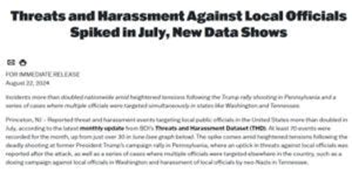
The Bridging Divides Initiative Understanding Threats and Harassment Against Local Officials (UTH) project is supported by the Brennan Center for Justice, the Anti-Defamation League, and Stand Together Trust. https://bridgingdivides.princeton.edu/UnderstandingThreats
The Bridging Divides Initiative https://bridgingdivides.princeton.edu/ describes itself as a “non-partisan research initiative that tracks and mitigates political violence in the United States” and they report in their article “Threats and Harassment Against Local Officials Spiked in July, New Data Shows”, released August 22, 2024, that threats to public officials have “more than doubled nationwide following the Trump rally shooting in Pennsylvania”.
New Data Shows”, that threats to public officials have “more than doubled nationwide following the Trump rally shooting in Pennsylvania”.
This article echoes the information the Dept of Homeland Security released to law enforcement in the immediate aftermath of the shooting. In the DHS notice, it also reports an uptick in threats to public officials and notes the shooting attempt on the former president as a trigger point.
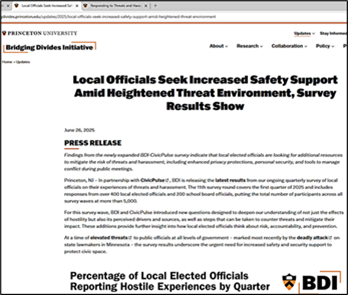
Note** For the latest numbers, please click here to visit Local Officials Seek Increased Safety Support Amid Heightened Threat Environment, Survey Results Show | Bridging Divides Initiative
A Local Problem
The BDI researchers reported threats and harassment against local officials “increased significantly in the second half of the year” in 2024. Similarly, our findings and experience align with those of the BDI, which identified threats directed towards city council members, school board members, poll workers, mayors, and local prosecutors.
As of the writing of this article, the BDI reports over 320 “threat and harassment events” reported in 40 states and the District of Columbia. These numbers indicate a 30% increase over the first seven months of 2023 and a 87% rise from the same period in 2022.

Question: The BDI report was no surprise, but if true, (it is) where is the federal and state funding to mitigate these threats?
Question: Since the Capitol Police, Sergeant of Arms, elected officials, the CTC, and BDI all agree that threats are increasing locally as well. For both members of Congress in their districts and for local officials, why are local law enforcement worried about “mission creep” and manpower issues?
Question: Where is the funding for specialized executive protection training, additional manpower, private sector contracts, the National Guard, and/or the Boy Scouts?
Our Point
The BDI, in their report, verifies what we, the CTC, and other agencies have repeatedly stated: threats will increase in number and violence, and that local “elected or appointed government officials and judicial officials” are most likely to face these threats.
So, knowing this, why is Donald Nieman, the professor at Binghamton University, writing “I fear that the discussion of political violence will take the same course as school shootings: We will lament them, propose solutions that go nowhere, and there will be more shootings.”
“Elected or appointed government officials and judicial officials are most likely to face these threats.”
And Finally Tonight, Some Hope
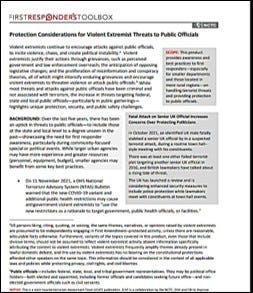
The Joint Counterterrorism Assessment Team (JCAT) 17 February 2022 publication, Protection Considerations for Violent Extremist Threats to Public Officials
The publication opens positively enough with “the increase in threats targeting federal, state, and local public officials — particularly in public gatherings — highlights unique protection, security, and public safety challenges.” So they get it.
And, thankfully it notes in the background section of the publication that “Over the last five years, there has been an uptick in threats to public officials — to include those at the state and local level to a degree unseen in the past — showcasing the need for first responder awareness, particularly during community-focused special or political events.”
Now, remember the JCAT is a collaboration by the NCTC, DHS, and FBI. Therefore, it is unlikely that these federal experts in the field would make such statements without any change.
“We will lament them, propose solutions that go nowhere, and there will be more shootings.”
Apathy vs. Facts
In the JCAT, BDI & CTC reports, they confirm what we at ISA and the elected officials have been saying for several years: “Threats against public officials have increased steadily since 2017.”
Current research indicates that 43% of public officials are under threat, with 41% of those being elected officials, election officials, and judges.
But just a reminder, some still believe that these “threats are just a ‘nuisance’ primarily initiated by individuals blowing off steam.
And we still have obstructionists like Sen. Markwayne Mullin, Sen. Richard Blumenthal, and Sen. Mike Rounds, whose concerns about privacy, fear of not being able to shake hands, or desire to know how much protection is enough are stopping serious progress.
How is this even possible with the body of evidence that these threats are real?
Now, consider the contrast between that “nuisance” argument and the 2023 Brennan Center for Justice report, which found that 75% of officials believe threats have increased in recent years, with one-third having personally experienced threats themselves.
Now let’s consider two assassination attempts on a former President, an arson on a governor’s mansion, and the shootings of elected officials in Minnesota.
“I fear that the discussion of political violence will take the same course as school shootings: We will lament them, propose solutions that go nowhere, and there will be more shootings.”
Cause and Effect
The CTC report, the Brennan Center for Justice, the Justice Department, and ISA all believe that our political discourse and society in general have become more polarized following the 2016, 2020, and 2024 presidential elections.
It’s easy to see and track the trends in social media. The increased levels of violent rhetoric by political pundits, candidates, and public officials seem to validate the findings in the CTC report that speculates the increased number of threats are a result of “a growing tolerance for violence among Americans,” or to put it another way, we have gotten used to violence in our political discourse.
Review
Dangerous rhetoric is again on the rise as we approach the midterm elections next November, and it has taken on a darker tone.
We are still in the post-election phase from the last election, where political violence increases with “followers” ready to use violence. Examining 2016 and 2020, much of the violence peaked after the elections.
It will be the same in 2025–2026, and we expect the weeks and months after the mid-term election to see an increase in violence directed at local and state officials.
Matthew Parker
But now what? We know threats are up, the shooting of a former president increased threats at the state and local levels, and the shooting of state officials makes it clear there is no will or funding available to help protect those public officials.
Recommendations and Solutions
The ISA Defending Democracy Initiative has been adamant that additional funding must be made available to deal with the increased threats at the local and state levels.
Congress passed legislation allowing some financing for physical security improvements to an office or home, such as cameras and alarms, as well as additional funding for personal security.
Unfortunately, republicans weakened the language of the rules to allow anyone to provide that protective security. No requirements for training or experience, and no real oversight. You can read more about these regulations at https://www.eptraining.us/defending-democracy-executive-protection-for-elected-officials/blog/
So Some Ideas
The Brennan Center for Justice:
- States should systematize security and safety practices to protect both officeholders and the public.
- States should systematically monitor threats against officeholders, taking care not to impinge on civil liberties.
- States should provide officeholders with adequate physical security resources and training.
- States should regulate the open and concealed carry of guns in places where officeholders engage with the public.
- States should permit candidates and officeholders to restrict guns at town halls, campaign rallies, and other public events.
- States should update campaign finance laws to permit candidates and their parties to spend on legitimate security measures.
1–2 If a state is going to ‘systematize security,” who is running the program? State or local law enforcement? Equally, who is “monitoring threats?
A centralized state office of protection? Or local law enforcement?
4–5 But you may have the 2nd amendment pro-gun lobby and extremists show up with guns to protest your new rules.
The Joint Counterterrorism Assessment Team (JCAT) 17 February 2022, remember the JCAT is a collaboration by the NCTC, DHS, and FBI.
So, this multi-agency with all its expertise, recommends the following “Best practices for responding to potential threats against public officials”:
- Monitor international, national, state, and local threat intelligence.
- Track international, national, state, or local issues that may serve as a pretext for violence during lawful demonstrations.
- Review open-source information before public engagements, paying particular attention to potential threats.
- Communicate any expectation of violence with interagency stakeholders, as well as the closest state or major urban area fusion center and the Joint Terrorism Task Force.
- Encourage reporting of suspicious activity and threatening communications to law enforcement.
- Before a public engagement, conduct background research to become familiar with the public officials and their particular responsibilities in your area of responsibility.
- Identify medical care facilities to facilitate the safe and prompt transportation of public officials or their staff in the event of a medical issue.
- Conduct site surveys of public engagement locations, paying attention to ingress and egress points for both pedestrian and vehicular traffic.
- Conduct routine training and practical exercises with public officials, public safety personnel, and other security partners to test security measures.
1–3 are basically the same as the BC #2 above. These sound recommendations are already in use by law enforcement and the private sector, though security classifications and access to LE material do limit the private sector to intelligence.
Note: 6–8 are typical close protection measures for a protective detail. It was a failure in these procedures that led to the security failures in Butler, PA, on July 13th, 2024.
Recommendation 9 appears to be derived from the ISA Defending Democracy playbook — training for public safety personnel.
The Joint Counterterrorism Assessment Team (JCAT) II
Recommendations for the officials, their families, and staff.
- “Public officials and their families should assess their online presence and any exposure to reduce the risk of a targeted attack.”
- Someone should “Educate public officials and their staff” on personal security measures, such as “changing routines and using caution when entering or leaving particular areas, especially when alone.”
- Encourage public officials to maintain close communication with law enforcement and security officials, and establish a point of contact for protection needs.
- Inform public officials how to report suspicious activity and threatening communications.
- Encourage public officials, as well as their family and friends, to adopt safe online practices to mitigate the risks of doxing or swatting, and for example, limiting the disclosure of details (location and time) of public engagements.
- Educate officials, family, and friends about safe habits and the importance of discretion when posting information online.
This is a primary responsibility of the protective detail and the threat assessment process. We look for these patterns and try to mitigate risks by using different travel means and routes, adjusting schedules to make them less predictable, and employing deception tactics such as using body doubles and multiple cars.
We are all for the official and their family being aware of their surroundings. Still, it’s a bit of a stretch to expect them to use different routes and varying schedules, especially when kids are involved in extracurricular activities like sports, which have fixed schedules.
Their recommendations, and then there are ours

What is missing from both the Brennan Center and the Joint Counterterrorism Assessment Team (JCAT) recommendations?
- Train state and local law enforcement in executive and close protection skills
- Assign a protective detail to public officials based on the threat
- Allocate funds for “legitimate security measures,” to reimburse law enforcement or to pay for private sector security?
Summary
We have been writing about protecting public officials for several years, and occasionally, you might see an article in the media or a government study that echoes our concerns.
Often, we cite such sources to reiterate our call for improved funding, training, or a more serious approach to safeguarding local public officials.
However, with the sources and their reports or studies highlighted in this article, can there be any doubt about the serious threats facing our public officials and our democratic process?
We are likely to see a growing exodus of people unwilling to serve in elected positions, as election volunteers may stop serving their communities.
As we’ve noted before, elected officials might refuse to tackle complex issues or vote on legislation due to threats to themselves and their families.
Since 2012, the Independent Security Advisors Executive Protection Training Academy has supported the goals of the Defending Democracy initiative by providing accredited executive protection training to state and local law enforcement. Currently, some public officials are protected by law enforcement officers trained by our team.
We have also prepared law enforcement to establish close protective details so that, in the event of increased threats, the agency or department can respond swiftly and provide the necessary security to mitigate the danger.
Visit our official blog posts for ISA training and program updates, or find us on Reddit, Facebook, Instagram, LinkedIn, Tumblr, X formerly Twitter and Medium
https://www.reddit.com/r/eptrainingus/
https://www.facebook.com/DPspecialist/
https://www.linkedin.com/company/independent-security-advisors-llc1/?viewAsMember=true
https://www.instagram.com/independentsecurityadvisors/?__pwa=1
https://www.tumblr.com/blog/executiveprotectionspecialist
https://isaexecutiveprotectiontraining.blogspot.com/
https://medium.com/@mparker.isa
Sources and citations
https://ctc.westpoint.edu/rising-threats-to-public-officials-a-review-of-10-years-of-federal-data/
https://www.dni.gov/files/NCTC/documents/jcat/firstresponderstoolbox/126s_-_Protection_Considerations_for_Violent_Extremist_Threats_to_Public_Officials.pdf
https://www.eptraining.us/defending-democracy-executive-protection-for-elected-officials/blog/
https://bridgingdivides.princeton.edu/UnderstandingThreats
https://bridgingdivides.princeton.edu/updates/2024/threats-and-harassment-against-local-officials-spiked-july-new-data-shows
https://bridgingdivides.princeton.edu/
https://www.brennancenter.org/our-work/research-reports/intimidation-state-and-local-officeholders
https://news.chapman.edu/2024/06/07/steady-rise-in-threats-against-public-officials-while-confidence-in-democracy-declines/
https://www.nbcnews.com/politics/local-officials-threats-harassment-data-rcna146063
https://www.npr.org/2023/08/12/1193463117/violent-threats-against-public-officials-are-rising-heres-why
https://www.axios.com/2022/11/01/princeton-threats-officials-elections-harassment
For previous ISA articles on the security and protection of public officials, please visit https://www.eptraining.us/blog/
#executiveprotectiontraining, #defendingdemocracyinitiative @eptraining.us
ISA Threat Assessment and Executive Protection Training in the news
.jpg)

Comments
Post a Comment